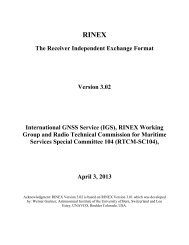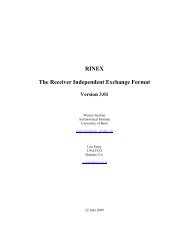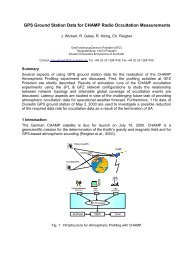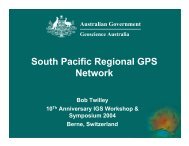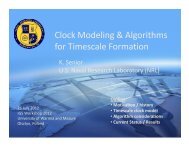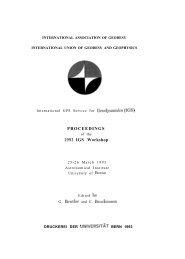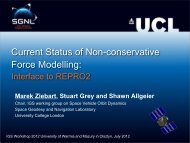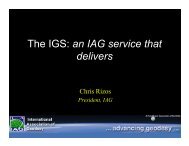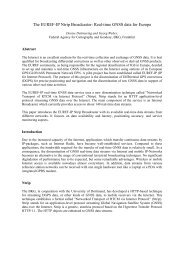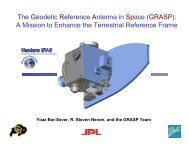known, the two solutions will be adjusted to the same value (since they both refer to thesame monument). In this case, it is acceptable to remove the redundant information so longas a flag is set to indicate this along with the information given in (vi) above. This flagindicates that more than one antenna height or type was used for that estimate, and thereforethe eccentricity information given in this file is incomplete..(viii) The header of the file include the epoch of the solution, start and stop time of inputdata, number of parameters, institutional identifier, date produced, a flag to indicatewhether or not velocity parameters are included, a code number to indicate presence andtypes of constraint, a unique solution identifier, a quality control code, and optionally adescriptive character string. A solution “type” identifier will indicate whetherrepresentations (a), (b), or (c) are used (see Section 3.3), and whether Cartesian orspherical coordinates are estimated, An ambiguity resolution identifier will indicatewhether the solution has been bias-fixed (integer carrier phase biases) or remains bias-free(real-valued carrier phase biases).3.5 Combination of orbital parameters and “sister solutions, ”. .Fixing the regional orbits to that of the global solution leads to the problem that somesatellites are better determined than others, and this information is no longer propagatedinto the regional solution. One consequence is that the regional covariance matrix will beartificially reduced. Another consequence is that the effects of badly modeled satellites willbe amplified in the regional solution. The first problem can be partly mitigated by ad hocresealing of the covariance matrix, or equivalently, by inflating the assumed data noise.The second problem might be partly mitigated by applying different weights to data fromdifferent satellites; however, the validity of this approach is questionable. On the otherhand, it is clear that a very badly modeled orbit should be eliminated completely from theregional solution. Therefore, it is important that GAC’S agree upon some method ofindicating orbit quality.Another approach is to combine not only station coordinate parameters, but also orbitalparameters and EOP between regional and global solutions [Lindqwister et aL, 1991;Dong, 1993; Feigl et al., 1993]. This will formally propagate orbital errors into theregional network solution. This approach is not as convenient from the point of view ofthe user, who must now estimate all the orbital parameters. Moreover, it is not clear howto do this properly unless (i) the RAC is using exactly the same software as the GAC, (ii)the same nominal orbital parameterization is used at the same starting epoch (e.g., is solarradiation parameterized the same way?) , and (iii) the same nominal EOP series is used.The use of stochastic orbit parameters makes this scheme even more difficult.Nevertheless, <strong>IGS</strong> should be prepared to accommodate those RAC’S who might cooperatewith GAC’s in this way, because in principle such regional solutions are more rigorous,and it may be useful to assess the relative performance of such solutions versus those usingfixed <strong>IGS</strong> products.In the case that RAC’S and GAC’S cooperate to combine orbital parameters, we nxommendthat the RAC and GAC cooperate in forming a NAC, and prepare and submit the fullycombined fiducial-free solutions themselves. In addition, the regional solution could besubmitted separately from the global solution provided the file header contains informationso that the pecessity of pairing the two solutions is apparent. We recommend an identif~erthat states the name of its “sister solution(s).” It might be convenient to submit sistersolutions for those users who are only interested in, say, the global portion.A complication arises when the global free-network solution is computed and submittedfirst, followed by a later computation of a regional sister solution, The problem is that77
acksubstitution of the orbital parameters has not taken place for the global solution.Therefore, in order to ensure that the two free-network sister solutions have the sameorientation, it is necessary to impose minimal rotational constraints on the global networkcovariance matrix (not the estimates!) prior to combining orbital parameters. This willensure that the orbits will not rotate as a result of the combination. Perhaps this should bean option, and another flag could indicate whether or not reference frame orientation isconsistent between the sister solutions. If not, the NAC’s can still use the 3 commonstations to ensure orientation consistency.3.6 Global calibrations for clocks and tropospheric delayClock Calibration Clock solutions produced by GAC’S have several uses for RAC’S. (i)Some software packages initialize satellite clocks as the first step, and it would bepreferable to use the most precise solutions available. (ii) Some packages (e.g., GIPSY)use a reference clock in order to realize coordinate time, and in this case it would be mostuseful if a good nominal clock solution were available for one of the “common stations” inthe regional network. This will ensure consistency between coordinate time for theregional solution and the coordinate time for the global solution (i.e., the orbits will appearin the right place at the right time!). We therefore recommend that both satellite clocks andstation clock solutions be available to RAC’s, so that both philosophies of data processingcan be easily accommodated. Minor modifications of the major software packages maybenecessary to read in these precise clock solutions and perform interpolation as necessary.. ,T oposphe~c call- It would also be beneficial for RAC’S to calibrate troposphericd~lay at one of the co~on stations, based on GAC solutions. This is especially importantfor smaller regional networks, where only a weak solution for absolute tropospheric delaycan be obtained from the regional data alone. Two possible approaches to troposphericcalibration are given. (i) GAC’s provide a line of sight tropospheric delay for every datapoint from a given station, These calibrations could be provided along with the data recordin the RINEX file, or alternatively calibrated RINEX files could be provided; (ii) the zenithtropospheric delay is given (both wet and dry components) at fixed time intervals (say,every 30 rein) which can then be interpolated by the RAC, on the understanding that theRAC applies the appropriate wet and dry mapping fimctions.We favor option (ii) since it becomes much easier to compare tropospheric calibrationsbetween GAC’S. We note that tropospheric estimation is done very differently by differentGAC’S, for example; some have a new constant zenith troposphere parameter over a fixedinterval of hours, some estimate the zenith troposphere as a random walk process, and it isallowed to vary every data epoch. It is unlikely that differences in mapping functions willcause a problem for data above 15 degrees elevation. These differences should be muchsmaller than the ability of the regional GPS data themselves to resolve the absolutetropospheric delay.3.7 “Noise-Calibrated Pseuabrange”The following discussion illustrates that much research can be done with regard tointegrating regional and global solutions. We should acknowledge that the technical issuesare quite complicated and techniques are likely to evolve and improve over the next fewyears, so I~S must be careful not to fix its mode of operation prematurely.The concept of GAC’S producing “clean” data has been around for a while, but “clean” inthis context has meant free of cycle slips and outliers. We can extend this concept bynoting that post-fit residuals from GAC solutions are very good estimates of the actual data,78
- Page 1 and 2:
●INTERNATIONAL ASSOCIATION OF GEO
- Page 3 and 4:
TABLE OF CONTENTS.FINAL AGENDA . .
- Page 5 and 6:
13:30 NGS14:00 S1014:30 EMR15:00 CO
- Page 7 and 8:
LIST OF PARTICIPANTS:Prof. Gerhard
- Page 10 and 11:
Table 1. Current IGS Analysis Cente
- Page 12 and 13:
The first field identifies the reco
- Page 14 and 15:
Summary InformationThe third produc
- Page 16 and 17:
From Figure 1 we find that there ar
- Page 18:
to define a reference clock in thei
- Page 22 and 23:
SESSION 2(IGS orbit products)
- Page 24 and 25:
1. introductionThe main objectives
- Page 26 and 27:
ecause of the above averaging. This
- Page 28 and 29:
RMS per center (m)o 0 0 0 0 0 oA0Iv
- Page 30: Scale (ppb)I I I I I 11+-b~ul0Amo&I
- Page 33 and 34: and NGS. Note that the day to day v
- Page 35 and 36: Rotation around X-axis (mas)1&0 0o
- Page 37 and 38: discussed in Section 3 are here see
- Page 39 and 40: -----------------------------------
- Page 41 and 42: Residuals in Meters1 1 1 1 1 1 1=%m
- Page 43 and 44: Residuals inMeters11111cnficJJw-o A
- Page 45 and 46: I I I—Residuals in Meters..—.
- Page 47 and 48: 1111ResidualsMeters,—{44
- Page 49 and 50: Residuals in MetersI I I II I I IIc
- Page 51 and 52: Rms in MetersI 1 ! I 1 10 n0 a0n.ff
- Page 53 and 54: IGS- and the COM-sets, but that the
- Page 55 and 56: Table 4.1 N.A. Baseline Repeatabili
- Page 57 and 58: ..Figure 5.1:Clock solutions for FA
- Page 59 and 60: specifically the preanalysis can be
- Page 61 and 62: discussion, a question as to whethe
- Page 63 and 64: SUMMARY OF SESSION 3This Session be
- Page 65 and 66: IGS POSITION PAPER, IGS ANALYSIS CE
- Page 67 and 68: and Earth orientation parameters (E
- Page 69 and 70: LbPIERS and IGSCentral Bureausand D
- Page 71 and 72: @ IGS will develop instructions, an
- Page 73: 2.2 Analysis Center System DesignFi
- Page 76 and 77: applied to the solution in order to
- Page 78 and 79: ..standard deviations. This is conv
- Page 82 and 83: errors, and can therefore be used a
- Page 84 and 85: International Terrestrial Reference
- Page 86 and 87: Thus, there is the potential of fee
- Page 88 and 89: 90” 100” 110” 120” 130” 1
- Page 91 and 92: adiation parameters for each satell
- Page 93 and 94: Bock, Y., R.I. Abbot, C.C. Counselm
- Page 95 and 96: SUMMARY OF SESSION 4This session st
- Page 97 and 98: INTERNATIONAL EARTH ROTATION SERVIC
- Page 99 and 100: x- differences with IERS0.001”I I
- Page 101 and 102: SUMMARY OF SESSION 5In the last ses
- Page 103 and 104: 1) I(X3 PROCESSING/REPORTS/FORMATSS
- Page 105 and 106: IGS should foster and encourage reg
- Page 107 and 108: ..INTERNATIONAL GPS SERVICE FORGEOD
- Page 109 and 110: ortL.s.4
- Page 111 and 112: 1234567a91011121314IsIt17ItIs2C2122
- Page 113 and 114: . Ruth Neilan16S Central BureauJet
- Page 115 and 116: ON1T.>● Jim ZumbergeJet Propulsio
- Page 117: PROPOSED ORGANIZATION OF THE INTERN




